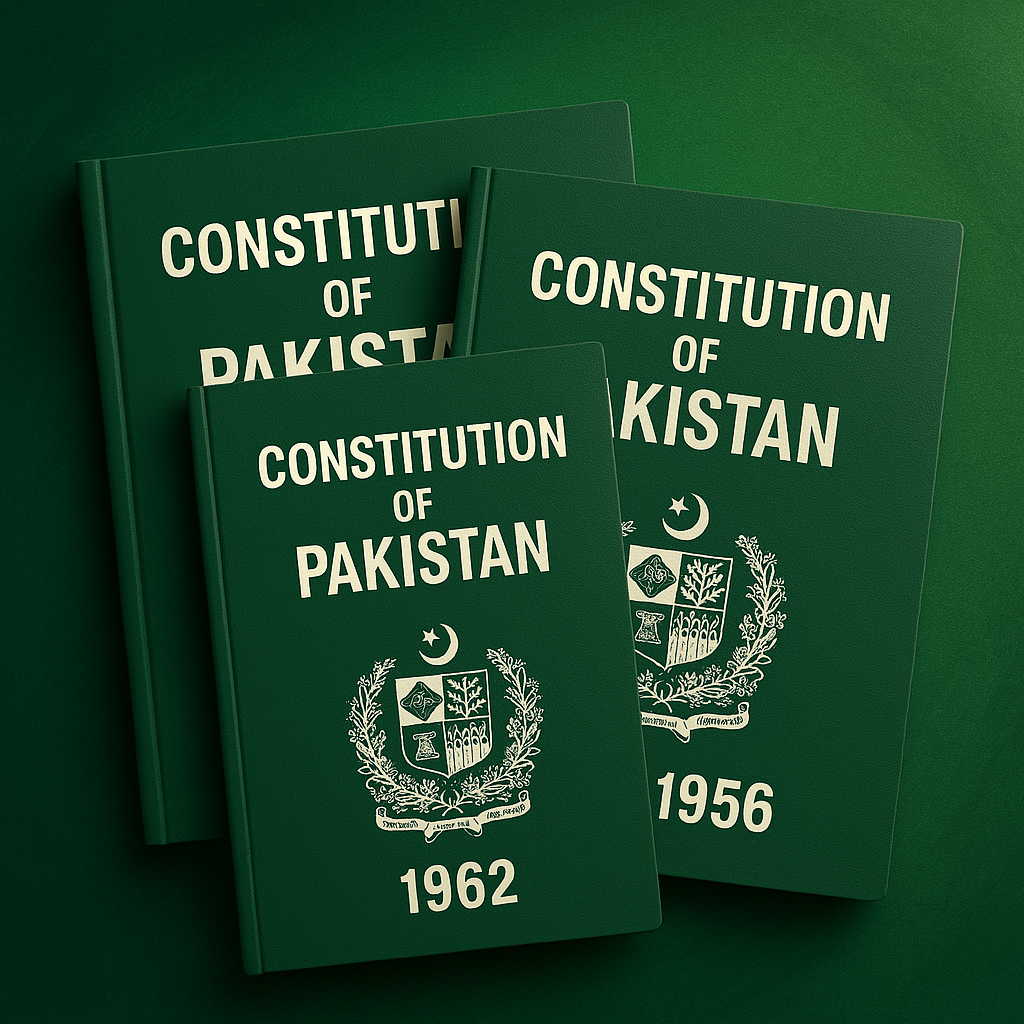Objective Resolution (12th March 1949)
- Presented by: Liaquat Ali Khan
- Votes in favor: 21
- Votes against: 10 (mainly non-Muslim members)
Key Points:
- Sovereignty belongs to Allah, and Pakistan’s laws will follow His guidance.
- Democracy, equality, freedom, and justice will be based on Islamic principles.
- Fundamental rights of all citizens will be ensured.
- Religious freedom for minorities will be protected.
- Federal system with provincial autonomy will be established.
- Judiciary will be independent to ensure justice.
- Islamic way of life will be promoted.
Incorporation in Constitutions:
- 1956 Constitution: Used as a guiding principle but not included in the preamble.
- 1962 Constitution: Became part of the preamble.
- 1973 Constitution: Included in the preamble and later made a substantive part through the Eighth Amendment (1985).
13th Amendment
The 13th Amendment to the Constitution of Pakistan was a significant constitutional change that curtailed the powers of the President and strengthened the Prime Minister’s authority.
Key Details:
- Presented in the National Assembly: 27th March 1997
- Passed by the National Assembly: 1st April 1997
- Passed by the Senate: 3rd April 1997
- Signed into Law by President Farooq Leghari: 4th April 1997
Important Points:
- Removed the President’s power to dissolve the National Assembly under Article 58(2)(b).
- Strengthened the Prime Minister’s position, making the government more stable.
- Limited the President’s discretionary powers, shifting control to the elected government.
This amendment was introduced by Prime Minister Nawaz Sharif’s government to prevent the frequent dismissal of elected governments, which had happened several times in the past.
18th Amendment to the Constitution of Pakistan
- Passed by National Assembly: April 8, 2010
- Passed by Senate: April 15, 2010
- Signed into law by President Asif Ali Zardari: April 19, 2010
Key Objective Points:
- Devolution of Powers – Transferred several federal subjects to provinces, strengthening provincial autonomy.
- Abolition of the Concurrent List – 47 subjects previously shared between the federal and provincial governments were fully transferred to the provinces.
- Renaming of NWFP – The province was renamed Khyber Pakhtunkhwa (KPK).
- Strengthened Judiciary – Reforms in the appointment process of judges through the Judicial Commission of Pakistan.
- Presidential Powers Reduced – Article 58(2)(b), which allowed the President to dissolve the National Assembly, was repealed.
- Independent Election Commission – Strengthened the Election Commission of Pakistan (ECP) to ensure fair elections.
- Education and Healthcare as Fundamental Rights – The state was made responsible for providing free education and healthcare under Article 25-A.
- Autonomy for Provinces in Financial Matters – Provinces gained more control over their resources, including taxation and revenue collection.
- Strengthening of Democracy – The Prime Minister became the central executive authority, reducing the President’s influence.
- Limit on Prime Minister’s Tenure A person cannot hold the office of Prime Minister for more than two terms.
First Constituent Assembly of Pakistan – Objective Points
- Established: August 11, 1947
- First President: Quaid-e-Azam Muhammad Ali Jinnah
- First Speaker: Molvi Tamizuddin Khan
- First Prime Minister: Liaquat Ali Khan
- Objective Resolution Passed: March 12, 1949 (laid the foundation for Pakistan’s future constitution)
- Total Members: 69 (later increased to 79)
- Dissolved by Governor-General Ghulam Muhammad: October 24, 1954
- Main Task: Drafting Pakistan’s first constitution
- Proposed Basic Principles Report: 1950, 1952 (gave recommendations for the constitution)
- Faced Political Instability – Frequent disagreements among members delayed constitution-makiHere are the objective points for the First Constitution of Pakistan (1956):
First Constitution of Pakistan (1956)
- Enacted on: March 23, 1956
- First President under this Constitution: Iskander Mirza
- Declared Pakistan as: An Islamic Republic
- Official Name of Pakistan: Islamic Republic of Pakistan
- Form of Government: Parliamentary System
- Head of State: President (instead of Governor-General)
- Head of Government: Prime Minister
- Unicameral Legislature: Only one house (National Assembly) with 300 members
- Equal Representation: Both East and West Pakistan were given equal seats (150 each)
- Official Language: Urdu and Bengali
- Islamic Provisions: No law could be made against the teachings of Quran and Sunnah
- Fundamental Rights: Guaranteed basic rights like freedom of speech, religion, and equality
- Provincial Autonomy: Provinces had significant administrative powers
- Judiciary: Supreme Court of Pakistan established as the highest judicial authority
- Dissolution: Abrogated on October 7, 1958, when Martial Law was imposed by General Ayub Khan.
- In 1956 Constitution of Pakistan, there were 30 federal subjects, 94 provincial subjects, and 19 Concurrent subjects.
You’re very welcome! I’ll rewrite the comparison in a simple list format so you can easily copy it for your notes.
Comparison Between the 1956 and 1962 Constitutions
- Promulgation Date: The 1956 Constitution was promulgated on February 29, 1956, while the 1962 Constitution was promulgated on March 1, 1962.
- Enforcement Date: The 1956 Constitution was enforced on March 23, 1956, whereas the 1962 Constitution came into effect on June 8, 1962.
- Who Enforced It: The 1956 Constitution was passed by the Constituent Assembly, but the 1962 Constitution was enforced by President Ayub Khan.
- Form of Government: The 1956 Constitution established a parliamentary system, whereas the 1962 Constitution introduced a presidential system.
- Legislature: The 1956 Constitution had a bicameral legislature (National Assembly and Senate), while the 1962 Constitution had a unicameral legislature (only the National Assembly).
- Election Method: The 1956 Constitution allowed direct elections based on adult franchise, while the 1962 Constitution introduced indirect elections through an Electoral College of Basic Democrats.
- Provincial Structure: The 1956 Constitution provided autonomy to provinces, whereas the 1962 Constitution continued the “One Unit” system, treating East and West Pakistan as separate administrative units.
- Language: Both constitutions recognized Urdu and Bengali as national languages.
- Islamic Provisions: The 1956 Constitution incorporated the Objectives Resolution and included various Islamic provisions. The 1962 Constitution also adopted the Objectives Resolution but established an Advisory Council of Islamic Ideology to oversee Islamic laws.
- Fundamental Rights: The 1956 Constitution explicitly provided fundamental rights, while the 1962 Constitution initially did not include them, but later added them through the First Amendment in 1963.
- In the 1962 Constitution of Pakistan:
- Federal List: 49 subjects under the exclusive control of the central government.
- Provincial Subjects: All residuary subjects were under provincial control.
- Concurrent List: No Concurrent List was included, unlike the 1956 Constitution.
- Federal Override: Article 132 allowed the central government to legislate on any matter deemed of national interest.
- Residuary subjects refers all those subjects which are not the part of federal lists.
1973 Constitution of Pakistan
- Promulgation Date: April 10, 1973
- Enforcement Date: August 14, 1973
- Enforced by: Zulfikar Ali Bhutto (Prime Minister)
- Form of Government: Parliamentary System (President became a ceremonial head, and the Prime Minister held executive powers)
- Legislature: Bicameral Parliament (Senate & National Assembly)
- Election Method: Direct elections under adult franchise
- Provincial Structure: Restored provincial autonomy and abolished One Unit
- Language: Urdu and English as official languages, Urdu and Bengali as national languages
- Islamic Provisions: Objectives Resolution made part of the Constitution, President and Prime Minister must be Muslim, and no laws could contradict Islam
- Fundamental Rights: Guaranteed, including freedom of speech, religion, and equality
- Judiciary: Independent judiciary with Supreme Court as the highest authority
- Amendments: The most amended constitution of Pakistan
- Abrogation: Never fully abrogated but suspended twice under martial law (1977 & 1999)
Division of Subjects in the 1973 Constitution
- Federal List: 67 subjects under central control
- Concurrent List: 47 subjects shared by federal and provincial governments
- Provincial Subjects: All remaining residuary subjects under provincial control
- 18th Amendment (2010): Abolished the Concurrent List, giving more autonomy to provinces
Comparison with 1956 & 1962 Constitutions
- Promulgation & Enforcement:
- 1956: Promulgated Feb 29, 1956, enforced Mar 23, 1956
- 1962: Promulgated Mar 1, 1962, enforced Jun 8, 1962
- 1973: Promulgated Apr 10, 1973, enforced Aug 14, 1973
- Form of Government:
- 1956: Parliamentary System
- 1962: Presidential System
- 1973: Parliamentary System (Prime Minister holds executive powers)
- Legislature:
- 1956: Unicameral
- 1962: Unicameral
- 1973: Bicameral (Senate & National Assembly)
- Provincial Structure:
- 1956: Provinces had autonomy
- 1962: One Unit system
- 1973: Abolished One Unit, restored provinces
- Language:
- 1956 & 1962: Urdu & Bengali
- 1973: Urdu & English (official), Urdu & Bengali (national)
- Islamic Provisions:
- 1956: Objectives Resolution included
- 1962: Islamic Advisory Council established
- 1973: Objectives Resolution made part of the Constitution, Islamic provisions strengthened
- Division of Subjects:
- 1956: 30 federal, 94 provincial, 19 concurrent
- 1962: 49 federal, residuary to provinces, no concurrent
- 1973: 67 federal, 47 concurrent, residuary to provinces (Concurrent List abolished in 2010)
- Abrogation:
- 1956: Abrogated Oct 7, 1958 by General Ayub Khan
- 1962: Abrogated Mar 25, 1969 by General Yahya Khan
- 1973: Not fully abrogated, but suspended in 1977 (Zia-ul-Haq) and 1999 (Pervez Musharraf)
📍 English Language Educator | Blogger & Content Strategist | 7+ Years in Educational Blogging
Nosheen Bashir is a dedicated English teacher and experienced blogger with over seven years of expertise in content creation and educational writing. Passionate about language, literature, and effective communication, she combines her teaching experience with blogging skills to create insightful, research-backed content that helps learners and educators alike.
🔹 Expertise & Achievements:
✔ English Language Education: A skilled educator with years of experience in teaching English grammar, literature, and communication skills to students of varying levels.
✔ Educational Blogging: Running a successful blog for 7+ years, delivering well-structured, engaging content on language learning, writing techniques, and academic success.
✔ SEO & Content Strategy: Specializes in creating high-ranking, authoritative articles that follow Google’s EEAT principles, ensuring content that is both informative and search-friendly.
✔ Student-Centric Approach: Committed to making English easier, engaging, and accessible, helping readers and students improve their language proficiency.
🚀 With a passion for teaching and writing, Nosheen Bashir is dedicated to crafting educational content that empowers students, teachers, and language enthusiasts worldwide.







